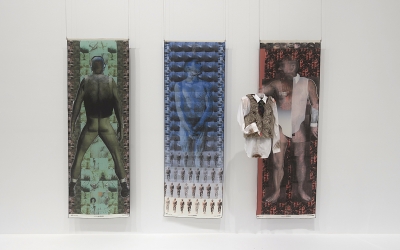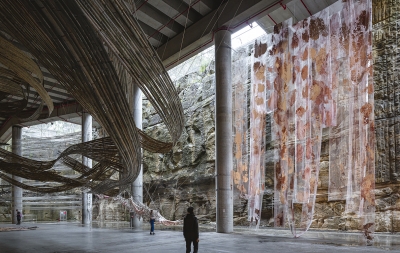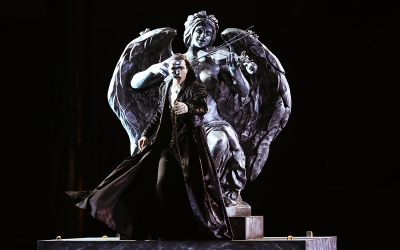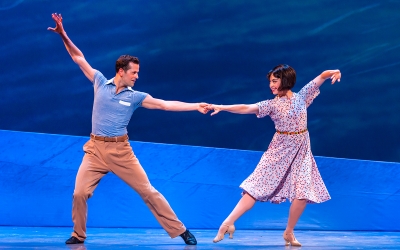Arts
Film | Theatre | Art | Opera | Music | Television | Festivals
Welcome to ABR Arts, home to some of Australia's best arts journalism. We review film, theatre, opera, music, television, art exhibitions – and more. To read ABR Arts articles in full, subscribe to ABR or take out an ABR Arts subscription. Both packages give full access to our arts reviews the moment they are published online and to our extensive arts archive.
Meanwhile, the ABR Arts e-newsletter, published every second Tuesday, will keep you up-to-date as to our recent arts reviews.
Recent reviews
In the middle of Bogotá’s Parque de la Independencia is a statue of Nicolaus Copernicus. Designed by the Polish sculptor Tadeusz Lodziana, it was gifted by the People’s Republic of Poland to the city of Bogotá in 1974, after the resumption of diplomatic relations between the two countries, which had been suspended from 1952 to 1964. This period overlapped with La Violencia in Colombia, a bloody civil war between conservative and left-wing forces, during which roughly 200,000 people were killed.
... (read more)We all know that emancipatory drives in the late twentieth century dislodged the hegemonic politics of social normativity through the movements of second wave feminism, civil rights, and gay activism, but it’s worth remembering that some rights took longer than others. Homosexuality was only fully decriminalised in Australia in 1997 (Tasmania being the last state to do so); same-sex marriages were not legalised until 2017.
... (read more)The twenty-third Biennale has been highly anticipated through two long years since Brook Andrew’s twenty-second Biennale suddenly closed in March 2020 as Covid took hold of the country, not to reopen for three months.
This year’s guiding idea, rīvus – meaning stream, but embracing rivers, fresh water, saltwater, lagoons, banks, confluences – is peculiarly topical, as water resources, in both scarcity and flood, become every year a more urgent issue.
... (read more)I don’t remember why we were talking about The Phantom of the Opera, the nuclear-proof blockbuster that has rung out from multiple cities every day since its London première in 1986. But I do remember the question posed so absurdly by my psychiatrist that it made me scoff, like the diva Carlotta discovering that she’s been relegated to a minor role in the masked one’s fiendish new score.
‘Do you think you enjoy the musical because you relate to the protagonist?’
... (read more)Not long into Will Arbery’s Heroes of the Fourth Turning a character brings out an acoustic guitar and is asked to play a song. He chooses Townes Van Zandt’s ‘Nothin’’, a melancholy ballad pulled from the annals of American folk music. When it was released in 1971, many assumed it represented Van Zandt’s struggle with drug addiction. In fact, as he explained two years before his death, the song was inspired by Nikos Kazantzakis’s The Last Temptation of Christ, a novel banned by the Catholic Church in 1955 for representing a Christ figure prone to human fallibilities.
... (read more)After a decade spent redefining Australian outback noir with Mystery Road (2013), Goldstone (2016), and their ABC TV offshoots, writer–director Ivan Sen turns his attention to a semi-futuristic Asian metropolis in Loveland, retaining his lean directorial focus while delving into even headier philosophical territory. His new film is a strange beast indeed – daring, beautiful, frequently confounding. Those expecting breakneck cyberpunk action will likely head home disappointed – the genre worlds Sen’s characters inhabit are usually more prison than playground – but those with the patience to indulge this alluring and moody experiment should find much to admire.
... (read more)It is called An American in Paris, but perhaps a more apt title would be The Americans in Paris. Not because the story is about two ex-servicemen who decide to ditch the victory parades back home and stay in a recently occupied city that is in desperate need of revival; but because the show itself is a triumph of the American musical as an art form, a kind of staking out of territory. It is, in its own way, an act of cultural imperialism, a banishment of old conventions in favour of something shiny and new. Proof of this comes deep into the second act, when a French character who fancies himself ‘a song and dance man’ suddenly launches into a fully fledged tap routine that ends with a high-kicking chorus line straight out of Radio City Music Hall. We are still in Paris, right?
... (read more)Sadly, stage productions of Benjamin Britten and Montagu Slater’s opera Peter Grimes are now few and far between in Australia, notwithstanding the fact that the work’s exploration of psychological distress and social ostracisation has lost none of its currency. Britten’s score, while incorporating significant modernist musical elements, also remains both accessible and attractive. And Australia can also boast of having produced two of the finest exponents of the title role in Ronald Dowd and Stuart Skelton (who sang the role in the Sydney Symphony Orchestra’s concert version in 2019).
... (read more)Despite being one of the most successful and influential operas of all time, Ernst Krenek’s Jonny spielt auf (1926) is now something of a stage novelty. We are inclined to assume, perhaps, that the operatic genre it spawned, the Zeitoper, contained the seeds of its own obsolescence. As a new production at the Gärtnerplatztheater in Munich demonstrates, however, the work retains a capacity to shock and inform, as well as to entertain.
... (read more)To say that Fromental Halévy’s opera La Juive (The Jewess) is a problematic work is a gross understatement. From the time of its successful première at the Paris Opéra in 1835 – it is one of the finest examples of French Grand Opera – it has been surrounded by controversy, periods of neglect, particularly during the 1930s, and even outright banning; its subject matter has been found confronting and frequently highly polarising. Although considered blatantly anti-Semitic by some, it was the finest opera of a successful Jewish composer.
... (read more)










